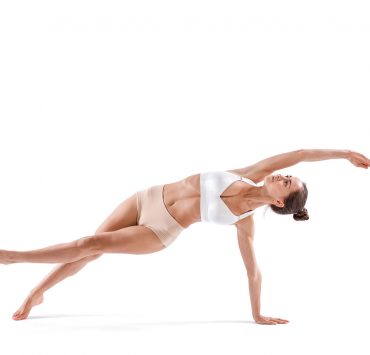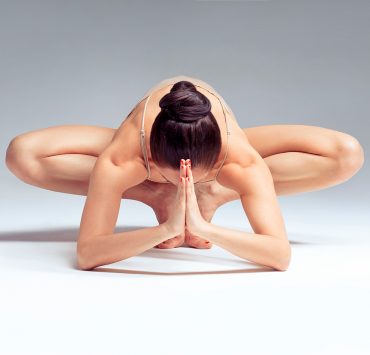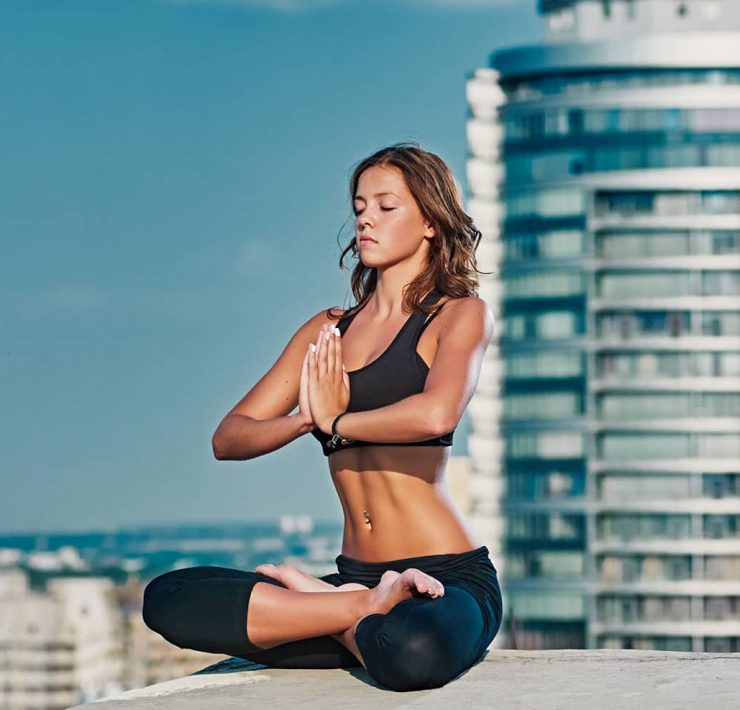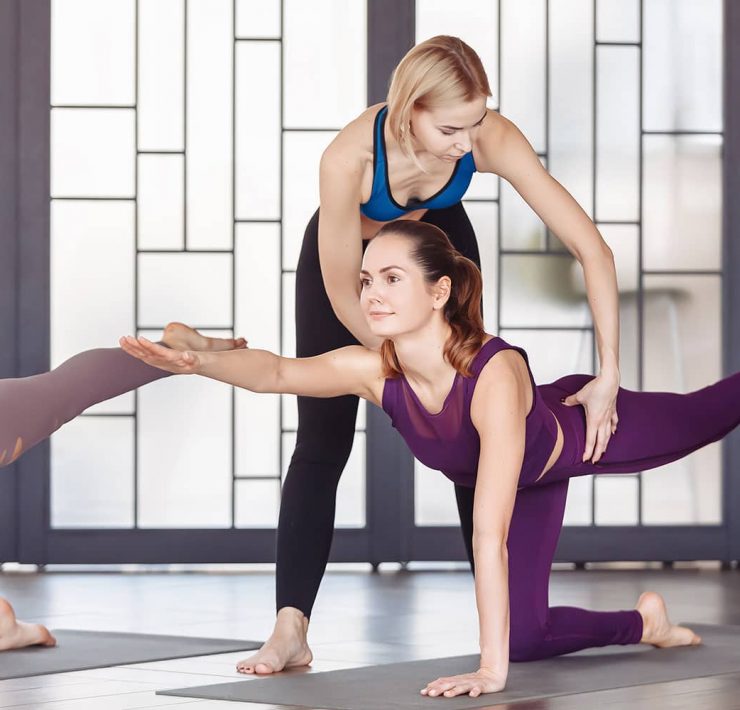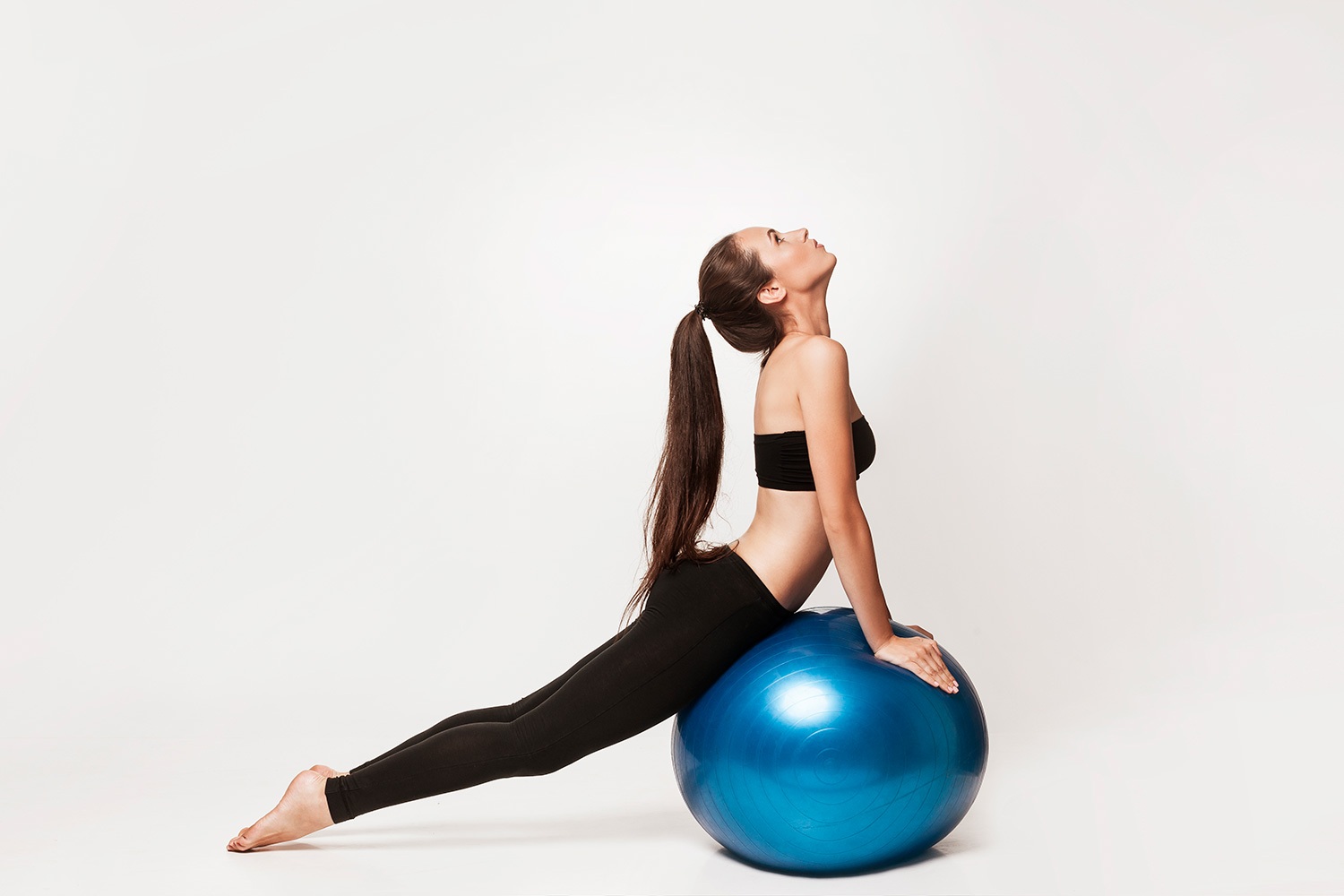
Susan views the world through a lens of spirituality, health,…
Props can be a helpful tools in yoga classes to ease you more slowly into a pose or help deepen you into asana which you’re already comfortable in. Props like blocks, straps, bolsters, thick blankets, and even chairs are already common in most yoga studios, but many yoga practitioners are finding new ways to challenge themselves in their yoga practice using yoga balls.
What is a Yoga Ball?

Yoga balls are also known as Swiss balls, stability balls or exercise balls. They are normally made of PVC or other soft elastic material and range in sizes from 35 through 85 centimetres. It was invented in 1963 by an Italian, Aquilino Cosani, and was originally called a “Pezzi Ball.” It was designed to help in treatment of newborn babies and infants in Switzerland with cerebral palsy. Soon, other doctors and researchers saw the benefits of using the balls as tools in physiotherapy, neurodevelopmental treatment, and other orthopedic and medical therapies.
Today, many athletes use these puncture resistant balls in training to develop balance, stability, and even as weight training tools.
Benefits of a Yoga Ball

In order to sit on a Yoga ball, your core muscles must be active and constantly engages to remain upright. This helps with stability, balance, and fine motor skills even while sitting. Many offices have started to replace regular office chairs with stability balls in order to help employees maintain good posture by strengthening the ab muscles to protect the lower back.
The unstable surface of a Swiss ball, as opposed to a flat surface to practice asana or other exercises on, allows the body to learn to react more quickly to remain balanced and focused. This not only has physical advantages but also helps with managing emotions to be calmer and more in the moment in order to concentrate and stay present.
Who Should Not Use a Yoga Ball

People with mobility issues in their legs or have a history of back pain should refrain from using a yoga ball without proper supervision and support. Practicing yoga asana or any exercise on a yoga ball requires more coordination and concentration from various muscle groups. It may be best to have a spotter ready at your side as you first start using a yoga ball to help catch or soften any falls that may occur until you get more comfortable using the ball. Transitioning for pose to pose will be the most crucial times to watch out for.
If your lower back begins to feel pain after sitting on a stability ball too long, check that you have the proper size of ball and that it is properly inflated. A ball that is under or over inflated will cause extra strain on your back muscles to keep you steady so limit the amount of time you spend sitting on the ball to one or two minutes in the beginning.
Safety Tips for using a Yoga Ball

Ensure that you are sitting on a yoga ball that is right for your height. Do this by sitting on the ball and if your legs are comfortably bent at a 90-degree angle, then that ball is likely the best size for you. As mentioned, consider having a yoga ball buddy nearby to spot you as you both get used to practicing yoga with a yoga ball to ensure you are both safe and don’t suffer any hard falls that may cause injury.
Once you have some safety precautions in place, here are some yoga asana and exercises you can try on a yoga ball.
Seated Twists and Other Seated Variations

For many yoga ball newbies, Sukhasana, or an easy seated pose on a yoga ball, may already be a challenge for your balance and already give a good workout to your core if you sit long enough. But you can also include other movements like spinal twists, cat-cow flexions, and side stretches as you sit.
You may also try lifting your arms up and down with your breath, opening and closing your arms as you inhale and exhale, or hold your arms in Garudasana or Gomukhasana with your feet flat on the ground.
If you feel stable enough, you may also try lifting one leg at a time, crossing one leg over the other, or lifting both legs carefully.
Phalakasana — Plank Pose

Planks can already be an intense pose and they get even more engaging with the use of a yoga ball. Try practicing plank with your hands on the ball first to test your balance and stability that way. For more of an intense core workout, put your feet on the ball and your hands on the floor and stabilize yourself here for a few breaths.
For the ultimate core challenge, place your belly on the stability ball and lift both your arms and legs for a Floating Plank (or Floating / Flying Locust). This will not only engage your core muscles but also give you a backbend.
Adho Mukha Svanasana — Downward Facing Dog

Similarly to the Plank variations on a yoga stability ball, you can also try exploring your Downward Facing Dogs with either your hands or your feet on the ball. Particularly with the feet on the ball version, ensure you have enough space around you to fall without hurting yourself if needed and take your time in the exploration of the pose, rather than aiming for the full expression of Adho Mukha Svanasana on the yoga ball.
If you want to try some movement in this pose, from Downward Facing Dog with your feet on the ball, inhale and transition into a plank pose by letting the ball roll from your feet towards your belly or thighs. Be careful as the ball passes your knees and don’t let it roll too far up past your belly button. On an exhale, transition back into Down Dog by letting the ball roll back from your belly or thighs towards your feet again.
Setu Bandhasana — Bridge Pose

Bridge Pose on a yoga ball can be a great hamstring stretch as well as a low-intensity way to strengthen and stretch your back and abdominals. With your back on the floor and feet on the exercise ball, push your hips up towards the ceiling, while keeping yourself safe and stable on the ball. You can either keep your legs bent with your feet on the ball, or extend your legs to straighten them depending on the intensity you are ready for in the pose.
For a more relaxed and restorative version of Setu Bandhasana on a ball, lay down with your back spine on the ball and relax. Allow the curve of your spine to follow the curve of the ball. But be careful that the ball doesn’t start to roll backwards and you hit your head on the floor! Keep your feet flat on the ground and your arms relaxed
Backbends

Various intensities of backbends can be achieved with the use of a stability exercise ball. The relaxed version of Bridge can be great at the end of any yoga practice or exercise to relieve tired muscles and decompress from any remaining tension.
Yoga balls can also be a good support for Wheel Pose with the hands extended up and over the head and palms on the ground for added stability. The ball will help keep the back bend shape in your spine so you can focus on strengthening your arms. Either keep your legs bent or extend them so the knees are straight. In either version, keep your feet flat on the floor.
Legs up on the Ball

As in any yoga class, it’s always good to close with a restorative pose like Savasana to allow the body to enter repair mode and read the benefits of your yoga practice. In Restorative Yoga, Savasana is usually done with the legs up the wall to help relax the body and at the same time gain the benefits of a gentle inversion that does not strain the body to get upside down.
A yoga ball version of Savasana with legs up the wall is Savasana with legs on the ball! Simply lay down on your mat and put your feet up on your yoga ball and stay there for at least 10 to 15 minutes in complete relaxation.
Conclusion
A yoga ball can be a helpful prop to use in a yoga class but must be used with care and mindfulness on safety first. It is best to add a yoga ball into your asana practice with the intention of exploring new possibilities of a pose rather than pushing yourself too hard to achieve a certain look on the ball that might force the body too quickly. With the addition of a yoga ball, you will see fast results anyway in your balance, stability, posture, and even your mood may be calmer due to the extra concentration it takes to stay still on an exercise ball.
What's Your Reaction?
Susan views the world through a lens of spirituality, health, and compassion. Her positive outlook on life shines through her writing, which is heavily focused on yogic living, meditation, and conscious eating.






